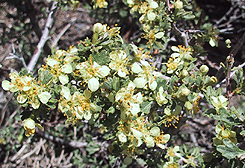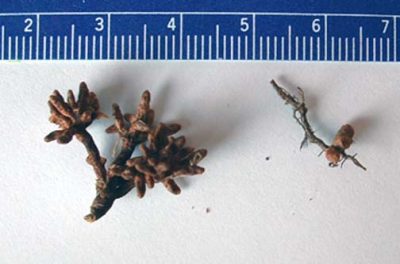
Purshia tridentata growing in the Sierra Nevada mountains.

Root nodules from Cercocarpus (top right) (D. Benson)

Dryas mats growing in Glacier Bay, Alaska, with cottonwood emerging from the mat ( NPS Photo).
Plant link - The Rosaceae
Up until recently (2004), only a few 16S rRNA gene sequences have been PCR-amplified from rosaceous root nodules, and all are from Cluster 2 frankiae (Benson, et al., 1996; Bosco et al., 1994). The actinorhizal Rosaceae appear to associate only with Frankia strains related to those that also nodulate the genera Ceanothus, Coriaria, and Datisca. These four groups of plants share a range in western North America, although Coriaria and Datisca are more wide spread. Interestingly, identical partial 16S rRNA gene sequences have been reported in Purshia tridentata, P. glandulosa, Cowania stansburiana, Chamaebatia foliosa,Ceanothus velutinus, C. griseus, C. ceruleus, and Dryas dummondii originating in North America (DRB, unpublished). It is tempting to speculate that the presence of Cluster 2 Frankia strains in these plants is related to their overlapping biogeography during the breakup of Laurasia and Gondwana in the late Cretaceous.
The limited amount of information available seems to suggest that rosaceous strains are distributed in areas where the plants grow, although very few soil trapping experiments have been done. Kohls et al. (1994) found that soils from Glacier Bay, Alaska, where Dryas is abundant, failed to induce nodules on Cercocarpus betuloides but did contain Frankia strains that nodulated Dryas drummondii and Purshia tridentata. Crushed nodules from Dryas also nodulated Dryas and Purshia but not Cercrocarpus. In the same study, ineffective (unable to fix nitrogen) nodules were formed on Cercocarpus ledifolius by CcI3, Cms13 and EuI1b. These strains are from Casuarina cunninghamiana, Cowania mexicana and Elaeagnus umbellata respectively suggesting that these strains may participate in forming ineffective nodules in the field. Other work has shown that Ceanothus, Cercocarpus, Cowania (now Purshia), Chamaebatia and Purshia can be nodulated by crushed nodules or soil from beneath Chamaebatia and Cowania (Nelson and Lopez, 1989).
Recent work by Vanden Heuvel et al (2004, 2005) indicates that the diversity of Frankia strains that nodulate rosaceous actinorhizal plants is very low. Furthermore, strains having identical 16S rRNA gene, glnA gene and the ITS region between the 16S and 23S rRNA genes can be found in nodules of Purshia, Cercocarpus, Chamaebatia, Ceanothus (Rhamnaceae), and Datisca (Datiscaceae) taken from the Western Sierra Nevada mountains. In addition, amplification of DNA extracted from the soil near these plants showed a similar low level of diversity (Vanden Heuvel, 2005).